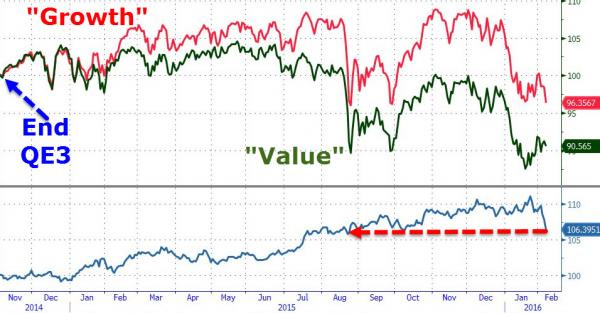With faith in “growth” faltering and the momo leaders rolling over…

JPMorgan warns there are still worries for the bears in the intermediate term…
For the SPX overall the ceiling remains clear: since its hard to foresee sustained upside to either ’16 EPS ests (~$120 is best case for the SPX) or the multiple (16x) then any move towards the mid-1900s should still be faded.
Sentiment is very gloomy fundamentally but investors in the last few days have been reluctant to sell/press shorts aggressively ahead of Yellen’s testimony (2/10 and 2/11) while over the intermediate term bears worry about:
1) a burst of brief but aggressive intervention by China to quell the deafening anti-yuan rhetoric (this may have already begun if the recent CNH strength is any indication);
2) further oil strength driven by additional “grand bargain” chatter (while an imminent OPEC/non-OPEC output deal seems unlikely there clearly is movement among some of the major oilproducing countries);
3) “shock-and-awe” from Draghi on 3/10 (although, incidentally, it is becoming increasingly apparent that stocks won’t be nearly as impressed by central bank largess going forward as was the case in the past and in fact the global adoption of negative interest rates seems to be doing nothing but hurting bank earnings and no stock market can sustain a rally if its banks aren’t participating in the strength. The historical “central bank eases, buy stocks” reaction function can still influence prices but increasingly only in a very ephemeral fashion).
With BoJ now clearly impotent, one wonders just how “shock and awe” Draghi can be…just as Bloomberg’s Mark Cudmore noted…
It’s been a week since the Bank of Japan’s surprise move to negative rates and it looks like Haruhiko Kuroda and his colleagues have started a trend. Global yields have collapsed as central bankers elsewhere feed the perception that they’ll follow suit with their own dovish policy. But why would they?
Traders no longer see the Fed raising again in 2016, and markets now deem it more likely the Bank of England will cut before they hike. Two-year German yields went below -0.5% this week as ECB-easing expectations go viral. Kuroda has promised to go even more negative if that’s what it takes to spur inflation.
What are these central banks hoping to achieve? Sure, the BoJ got lower rates — they are now negative out to nine years — and there’s abundant cheap cash sloshing about.
However, cheap cash has been available for a generation in Japan and it hasn’t stoked an economic boom. Over the last 20 years, the average two-year yield has been 0.33% — hardly extortionate — mean inflation has been 0.1%, and GDP has expanded 0.8% a year. Not exactly a ringing endorsement of dovish policy.
Japanese equities have slumped since the BoJ’s decision. The Nikkei 225 today closed down 1.3%, pushing the index to its lowest weekly close since 2014.
Only two exchange rates really matter for the Japanese economy -– CNY/JPY and USD/JPY -– and the yen is significantly stronger against both since the BOJ action. In fact, the yen’s set for its largest weekly gain versus the dollar since 2008. So much for an economic boost from a weaker currency.
With debt at nearly 250% of GDP, Japan needs inflation more than any other government in the world. Market reaction suggests there’s little confidence marginal monetary policy changes are going to help them achieve it.
Policy-makers globally are turning a blind eye to these failures and seem all too willing to tag along.













Leave A Comment